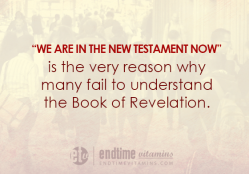Here’s the right way of studying Revelation according to the book itself
Yes, the secret of understanding the Book of Revelation is written in the very first few verses of the book itself. Ignoring this will always lead to selective readings and distorted understanding of many passages in the book.
Let’s get started.
1. Center of study must be Jesus
“The Revelation of Jesus Christ…” Revelation 1:1 KJV
Reading Revelation is like watching a movie. There are many illustrations and imagery, and it’s easy to be carried away by these. One thing that an honest Bible student should consistently have in mind while reading the book is to look and stay focused on Jesus:
- where is Jesus in the scene?
- how Jesus is described and what’s the significance of the description?
- what is Jesus doing and how it affects me as a reader?
These are some of the questions that you must always put in mind while studying the Book of Revelation. In fact, this is how we should study the whole Bible.
Our focus on searching for truth is on the Truth Himself, Jesus our Savior.
2. Study with respect and humility to the Source
“The Revelation of Jesus Christ, which God gave unto Him…” Revelation 1:1 KJV
Since the visions are from God, we need to ask the Holy Spirit to give us the right understanding of what is written. And so, a humble prayer should always start and end the reading.
When things are difficult to grasp, pray. When things are easy to comprehend, thank God in prayer.
3. Use the Historicist approach
These are the different approaches men is using on how to study Revelation:
- Preterist – all prophecies are already fulfilled in the early centuries and thus not much of it are of relevance today
- Futurist – prophecies are to be fulfilled in the far future, and so not critically of importance today
- Idealist – simply taking the spiritual application of the visions
- Historicist – the visions are with actual historical events from the time of John up to the second coming of Jesus, and even beyond.
Among these four, only the Historicist approach makes sense. Only the Historicist perspective gives us the urgency to seriously consider and read this important book in the end times. The first three give us reasons to ignore the Revelation “at the time being since it’s not too important”, a revelation of Jesus Himself for the people in the end times.
Let’s take the clue from the book itself to know which of these approaches should be followed.
“The Revelation of Jesus Christ, which God gave unto him, to shew unto his servants things which must shortly come to pass;” Revelation 1:1 KJV
This verse tells us that the fulfillment of the prophecies will start immediately after the giving of the vision. In other words, it commences from the time of John in the first century AD. Also, verse 19 added this…
“Write the things which thou hast seen, and the things which are, and the things which shall be hereafter;”
…which tells that the fulfillment of the prophecies continues to unfold up to the present and even in the future. In fact, the prophecies in Revelation ended up when the redeemed saints are all in the new heavens and new earth, the event that every believer of Jesus is waiting.
Historicist approach allows us to see all the events and prophecies in a meaningful history timeline which gives us a full understanding and appreciation of God’s leading to His faithful.
4. Focus on the real meaning, not with the symbolism
When studying the Bible, the rule of thumb is to take the words literally unless it is obviously figurative, metaphorical, symbolic, and allegorical. But Revelation is unique. Let’s get the clue from chapter 1 and verse 1.
“…and he sent and signified it by his angel unto his servant John” Revelation 1:1 KJV
The original word used for ‘signify’ is ‘semaino’ which means ‘to give a sign’ or ‘to make known using a sign’ which tells us that the angel who gave John the vision used signs, symbols, illustrations, or visuals.
Thus, the language used to describe Revelation’s prophecies must not be interpreted literally for the most part of it. Unless the verse points to a literal meaning, we need to interpret Revelation symbolically.
The symbolism is meant to identify real events, people, places, or objects; so do not stop on nor let yourself wander with the graphical symbolism, but instead focus on the real meaning of it.
5. Follow the lead to Old & New Testament accounts
The meanings of these symbols must be derived from the Bible itself, not from news clips nor modern day literature. The Apostle John used Old and New Testament language in allusion manner: a word here, a phrase there, a name here, or a place there. Going back to the book in the Bible where John took the hint will help us better understand the message.
In Revelation 2:20 for example, it says “you allow that woman Jezebel… to teach and seduce My servants”. One may recall that there’s indeed a woman named Jezebel in the time of prophet Elijah (1 Kings 19), and so reading that story will give us better insight into studying the church in Thyatira in Revelation chapter 2.
The visions in Revelation toured around God’s sanctuary, thus, a study of the earthly sanctuary will definitely give light to the study of Revelation.
The books of Exodus and Leviticus give detailed descriptions of what was happening in the earthly sanctuary. The book of Hebrews takes that knowledge of the earthly sanctuary to direct its readers to that heavenly and original sanctuary where the earthly version was copied. This makes Revelation a book where both the Old and New Testament meet and end.
Do not ignore the allusion or words used by John to lead you to the other accounts in the Bible. It is highly valuable.
You may also like

7 Compelling Reasons Why You Should Read The Book of Revelation
"The Revelation of Jesus Christ, which God gave unto Him, to shew unto His servants things which must shortly come to pass..." that alone should compel us to read and study the book!

Millions of sincere Christians will not understand the Book of Revelation because of this belief…
The Old Testament books are keys to understand the New Testament, and thus we should give equal importance to the books of the Old Testament as we do for the New Testament.

Trusted and tested hope against sickness, pain, tragedies, darkness, and ultimately sin
"Wherefore comfort one another with these words." 1 Thessalonians 4:16-18 ASV

24 Elders in Revelation are representatives of the unfallen worlds
Who are the 24 elders in Revelation? Why they can't be the redeemed people? Are there other created beings that did not fall into sin?
6. Visions are in cyclic pattern (repetition), not linear
Any book in the four Gospels was written in a linear form. This means that one can read the book from the birth of Jesus up to His ascension. Each chapter is a progression to complete the whole story. This is not the case with Revelation.
Although events in Revelation started from the time of Apostle John (the writer) and ended with the establishment of the new heavens and new earth, but visions in many chapters or sections are in cycle form. This means that a reader should expect to go back and forth across chapters to get the full details of the events.
In each repeated event, there is a focus or emphasis on some particular events or characters. The reader is expected to put all these emphasis and details in one linear timeline to get a better grasp of the prophecy.
Let take for example the prophecy regarding the dominance of the Little Horn during the 1,260 days. As readers will notice, the 1,260 days has been repeated in different ways in Revelation chapters 11, 12. If a strict linear interpretation of the prophecies is to be applied it will appear that the book of Revelation is telling about two occurrences of 1,260 days in the earth’s history. But that is not the case. Both chapters are pertaining to the same one event but with added details when the event was repeated in another chapter.
Another example is the downfall of Babylon and her cohorts. It was mentioned in Revelation 16:12-17 with the sixth and seventh plagues and was later amplified in Revelation 17-19.
7. Read and listen to others (personal and group Bible study)
“Blessed is the one who reads aloud the words of this prophecy, and blessed are those who hear…” Revelation 1:3 ESV
Aside from reading aloud the prophecies in this book in church worship services, there should be a personal study and sharing through group Bible learning. Your interpretation should not be private. Let others test it. Learn from others too.
The sermons and lectures on this topic at audioverse.org are of great value for listening. Those are highly recommended.
8. Be patient
In connection with items #6 and #7, you need to be patient in studying the book of Revelation. You are expected to have some background on the stories and passages from the Old and New Testament as the writer of Revelation used languages and illustrations from the other books of the Bible. So taking some time to read those accounts will help a lot in understanding what Apostle John meant in Revelation.
Some people find it helpful to divide the book into broader sections first and get the summary of each before delving into more details. These summaries should not violate the fundamental teachings of Christ as established early on the first five books of the Bible.
As you need to listen to others, it is advisable not to limit yourself in one understanding or interpretation.
“Test every spirit” and hold on to what is good.
Remember that truth is progressive and thus you may need to be open to get the right understanding.
9. Do the challenges–act on it
“… and who keep what is written in it, for the time is near.” Revelation 1:3 ESV
Studying the book of Revelation is not enough, there should be the “keeping” of it. Keeping does not mean to cover and put it aside. The keeping of the Sabbath gives us the same thought for the keeping of the words in Revelation. When one keeps the Sabbath, there are actions associated with it such as going to church, reading the Bible, praising and singing, ministering to the needs of others, etc.
Thus, when we keep what is written in Revelation it means doing something about it. For example, upon learning the lukewarm status of the Laodecian church to the point that God wanted to vomit it, ask yourself: What must I do (upon the leading of the Holy Spirit) to move away from that Laodecian condition? If you got the answer, then act on it!
By continuously reading, listening, and sharing what is written in the Book of Revelation God will surely give more profound insights and “eureka” moments resulting to a deeper faith and meaningful walk with Jesus.
May this short article helps us find the real meaning of God’s revelation to us as we face the prophecies fulfilling in our midst. Happy learning!
Don’t forget to share the good news. Act now!

